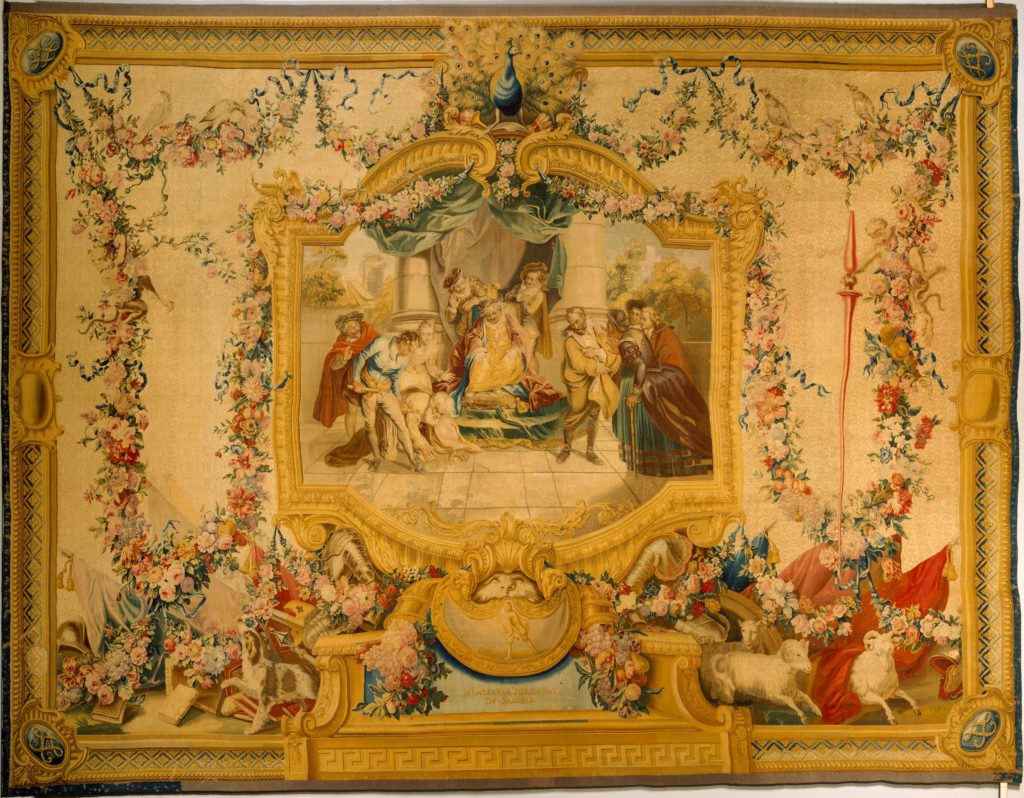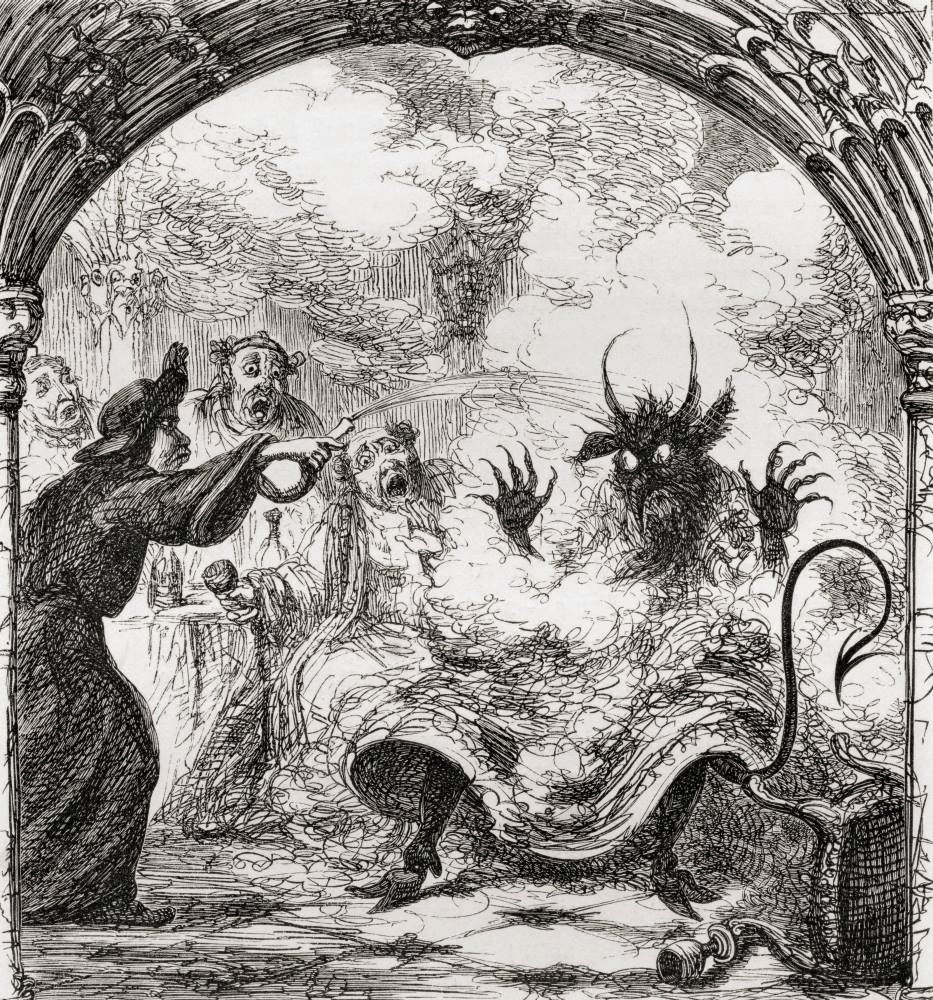A “lay” is a form of poetry, as I have had the chance of explaining when I wrote about “The Lay of St. Cuthbert”, and this one is part of the works known as The Ingoldsby Legends, a collection of humorous pseudo-folklore put together by Thomas Ingoldsby of Tappington Manor, pen name of clergyman Richard Harris Barham of Canterbury. The first piece I did on them was about a prose piece, “The Leech of Folkenstone”, and back there I got the chance of talking about the publication history of this collection, now in the public domain. You can read the full text here, at Ex-Classic, a website with the mission of digitizing lesser-known works that were classics for more renowned authors.
“A Lay of Saint Nicholas” is one of the “lays” in the first series, alongside “A Lay of St. Dunstan“, “A Lay of St. Gengulphus“, and “The Lay of St. Odille“; in the second series we have “The Lay of St. Aloys“, “The Lay of the Old Woman Clothed in Grey”, and “The Lay of St. Cuthbert”, which I already talked about.. You can read it here.
Arthur Rackham did at least one colour plate for this tale, when he illustrated the book between the 1898 edition and the 1907 reworking. The one he did is a little bit of a spoiler, so I’ll put it where it belongs, at the end of the tale. As usual, first things first.
1. St. Nicholas: who is this guy?
It’s the same St Nicholas you’re thinking about: St. Nick, the inventor of Santa Clause. The author makes this clear with an opening note in Gothic letters and fake old English, saying «’Nycolas, cytezyn of ye cyte of Pancraes, was borne of ryche and holye kynne. / And hys father was named Epiphanus, and hys moder Johane» and approaching the very delicate issue of the origins of St Nicholas. According to some sources, his parents were Epiphanus (Ἐπιφάνιος) and Johanne (Ἰωάννα) like stated here; according to other sources they were named Theophanes (Θεοφάνης) and Nonna (Νόννα), but in both cases they were wealthy Christians in the Diocletian Era, a quite turbulent time. There’s no evidence that the guy actually existed and accounts blur with what supposedly was his uncle, the bishop of Myra also called Nicholas.
The most famous account of his life is Michael the Archimandrite‘s Life of Saint Nicholas, in which you can find the story of him leaving money as an anonymous gift for girls who were left without a dowry, which in turn led to the whole Santa Clause business. He was supposedly born in 270 AD in the port of Patara, on the south-west coast of Lycia in current Turkey.
I have zero idea as to why the narrator mentions a city of Pancraes (no account of that: the first and only thing that comes to mind is this Pancras). To complicate things further, the additional note also meddle up the history, for narrative purposes.
He was born on a cold frosty morning, on the 6th of December, (upon which day his feast is still observed,) but in what anno Domini is not so clear; his baptismal register, together with that of his friend and colleague, St. Thomas at Hill, having been ‘lost in the great fire of London.’
As all Saints, his holiday is not the day he was born (supposedly March, 15th) but the day he died. Since St Nicholas will be seen in this tale, but also since the celebration is quite popular in Anglo-Saxon countries, the narrator decides to give us this twist, preserving the date but changing around the meaning. Or he’s simply wrong.
The Great Fire of London mentioned here is an excuse, as it is customary, for pretty much anything: what is usually indicated as “the great fire” is the one which started on September, 6th 1666, which destroyed 13,200 houses, resulting in the lost of the homes of 70,000 of the City’s inhabitants, 80,000 at the time. The losses also included 87 parish churches, the Tower of London and St Paul’s Cathedral. Samuel Pepys, whom we can always rely upon to write up about stuff, has a lot of entries in his diary: you can read them here.
After framing Saint Nicholas as such, the author proceeds in his notes to tell us a little bit more about the guy, with the usual wit:
St Nicholas was a great patron of mariners, and, saving your presence — of Thieves also, which honourable fraternity have long rejoiced in the appellation of his ‘Clerks.’
Saint Nicholas is the patron saint of lots of things: sailors, as we’re reminded here, but also repentant thieves and non-repentant merchants, archers, prostitutes, children, brewers, pawnbrokers, unmarried people, and students. All the bad apples. The reason from part of this is fairly obvious from the Santa Clause legend. He’s the patron of mariners because of a journey he supposedly made to the Holy Land, during which he tamed a sea storm thus preventing his ship from sinking.
According to another story, during 311 Myra went through a terrible famine, and Nicholas asked a trading vessel, which was stopping by in the famished city, to unload part of its cargo of wheat: he was able to convince the sailors and reassured the merchants that they would have no trouble when, once in Constantinople, they would have to face the Emperor with a lesser cargo of wheat. The shop obliged and, once in Constantinople, they found out that the wheat hadn’t change its weight.
2. The Story
The story is also framed, in these first lines, as a reprise of an episode in Miguel de Cervantes‘ The Ingenious Gentleman Don Quixote of La Mancha, specifically the episode in which Sancho is made king of an island (Chapter 45).
Cervantes’ story of Sancho’s detecting a sum of money in a swindler’s walking-stick, is merely a Spanish version of a ‘Lay of St. Nicholas,’ extant ‘in choice Italian’ a century before Honest Miguel was born.
The detail of a walking cane concealing money is a recurrent theme in folklore, has its own Aarne-Thompson index which is 961B – Money in the Stick, and is also present in a story in folio 25 of the Nedarim, a part of the Talmud which is the central text of Rabbinic Judaism. You can find a comparison of the two episodes on the Mostly Kosher blog and the full English translation of this specific part of the Talmud can be found here and it goes pretty much like this:
A man with a monetary claim upon his neighbour once came before Raba, demanding of the debtor, ‘Come and pay me.’
‘I have repaid you,’ pleaded he.
‘If so,’ said Raba to him, ‘go and swear to him that you have repaid.’
Thereupon he went and brought a [hollow] cane, placed the money therein, and came before the Court, walking and leaning on it.
[Before swearing] he said to the plaintiff: ‘Hold the cane in your hand’. He then took a scroll of the Law and swore that he had repaid him all that he [the creditor] held in his hand.
The creditor thereupon broke the cane in his rage and the money poured out on the ground; it was thus seen that he had [literally] sworn to the truth.
Within Don Quixote, the scene is known as Sancho’s judgment. There’s also something like this in the medieval legend of Hamlet, as told by Danish historian Saxo Grammaticus in his work Gesta Danorum. Cervantes’ retelling of the tale is often illustrated: see this tapestry at the Metropolitan Museum, and the corresponding journal article, this painting in the style of Charles-Antoine Coypel.
3. Framing
The framing, as it often happens with the “lays” in the Ingoldsby Legends, is delegated to a Latin quote. This time, the quote comes from Roger of Howden, a 12th-century English chronicler mostly known for his Gesta Henrici II et Gesta Regis Ricardi, later revised and updated in his Chronica magistri Rogeri de Hoveden. Roger had accompanied King Richard through Sicily to Palestine during the Third Crusade, after being a crucial messenger to the king during the coup staged by William de Longchamp to overturn his co-ruler Bishop Hugh du Puiset and seize control of the Country. He eventually returned with the fleet of Philip II of France, thus not taking part in the less-than-merry journey home of his king.
‘Statim sacerdoti apparuit diabolus in specie puellæ pulchritudinis miræ, et ecce Divus, fide catholica et cruce et aqua benedicta armatus, venit, et aspersit aquam in nomine Sanctæ et Individuæ Trinitatis, quam, quasi ardentem, diabolus, nequaquam sustinere valens, mugitibus fugit.’
— Roger Hoveden.
The quotation loosely translates as: ‘As soon as the devil appeared to the priest, in the form of a beautiful woman, he came armed with his Catholic faith and the cross and holy water, he sprinkled the water upon her in the name of the Holy and Undivided Trinity, and the devil, almost burning as he cannot withstand this, he ran away bellowing’. Yes, I said loosely, ok? You got the general point.
4. As the Story goes
The story (that you can read here as usual) opens with a beautiful maiden arriving to talk to the Abbot of St Nicholas’ Abbey and refusing to talk to anybody else, even if our Abbot proposes her a great deal of good people: Monsieur Michael (abbreviated in Mess) and Monsieur John, respectively the archangel and the evangelist though there’s a great deal of Michaels and Johns to pick from, both defined «Sage Penitauncers», which is an odd term coming from Middle-English, describing someone appointed to administer penance.
There’s also a St. Cathrine (unclear which one of the many) and Ambrose, «the anchorite old and grey», meaning someone who retired from public life in order to live like a hermit (something Ambrose never did, so again this is Saint fan-fiction). Upon this line, Bert Leston Taylor picks up to write his own “The Lay of St. Ambrose”: you can read it here.
Regardless of this huge amount of Saints to pick from, the maiden doesn’t want to talk to anyone but the Abbot and such presents her case: she’s of royal blood, «from the old Plantagenet’s line», meaning she’s related to a bunch of nice people like Richard III. Among the servants of her father, whom she does not name, she mentions both the «Compte of Eu», a French Middle-Ages fief in the north of Normandy, and the Lord of Ponthieu, another feudal county in northern France. Among the different suitors she had, the Duke of Lorraine gained her father favour. So, if we try and triangulate these references, we might get a general idea of when the tale is set and how much the author has fun to confuse us:
- the title of “Counts of Eu” is something we find from 996 with the first Count, the illegitimate son of Duke Richard I of Normandy, all the way through 1974 (the guy is still alive), so it really doesn’t help us;
- the first Count of Ponthieu is Helgaud III, who died in 926 against the Normans, and the last one was James I of Bourbon, son of Mary of Avesnes, who kept the title between 1351 and 1360, so we’re narrowing it down a bit;
- the concept of a Duke of Lorraine, however, is what might help us narrowing it down furtherly, as Lorraine only had seven Dukes, before being divided into districts: the first one was one Gebhard, in 903, and the last one was Bruno, Archbishop of Cologne, who stayed until the division in 959.
So, as you can see, if we have a last Duke of Lorraine in 959, but the first Count of Eu is only to be found from 996 on, someone’s messing with us. Badly.
Anyway, it’s the Duke of Lorraine we’re mostly concerned with, in our tale, because our fair lady has been promised to him, but apparently he’s «uncommonly plain», so the maiden vowed that she would never be married with him and fled to the convent.
‘So hither I fly, in lowly guise,
From their gilded domes and their princely halls;
Fain would I dwell in some holy cell,
Or within some Convent’s peaceful walls!’

The most important contribution Lorraine ever gave to modern civilization: the bacon quiche (picture and recipe here).
The Abbot reassures the maiden that no one will find her here, and that the walls of the Church have been built to guard the flock from wolves, particularly young lambs, and everyone has this strange feeling that he’s suddenly hitting on her, maiden included. So, when he invites her to dine with him, the reaction is what you might expect.
‘Friends would whisper, and foes would frown,
Sith thou art a Churchman of high degree,
And ill mote it match with thy fair renown
That a wandering damsel dine with thee!
The Abbot extends the invitation to other people, covering pretty much the whole hierarchy of a convent (Simon the Deacon with his beans and lettuces, Peter the Prior, Francis the Friar and Roger the Monk).
If you know the Ingoldsby Legends by now, there’s no way Richard Barham will let us go without a menu, so here’s what the merry company is eating:
- turkey and chine, where chine is defined as the bony part of a meat chop;
- Liver and gizzard, where gizzard nowadays is a term to indicate a particular kind of stomach, present in reptiles and certain birds, but in Middle-English simply refers to giblets, any kind of edible interiors of an animal.
It’s not really about what they eat, however, and more about what (and how much) they drink.
There was no lack of old Sherris sack,
Of Hippocras fine, or of Malmsey bright;
And aye, as he drained off his cup with a smack,
He grew less pious and more polite.She pledged him once, and she pledged him twice,
And she drank as a Lady ought not to drink;
And he press’d her hand ‘neath the table thrice,
And he wink’d as an Abbot ought not to wink.
You turn around, to carry a drunk Roger the Monk and tuck him in bed, and the next thing you know, there’s the Abbot singing with the lady.
In his ear was ringing the Lord Abbot singing,–
He could not distinguish the words very plain,
But ’twas all about ‘Cole,’ and ‘jolly old Soul,’
And ‘Fiddlers,’ and ‘Punch,’ and things quite as profane.
The Monks begin to worry and Porter Paul, in particular, begins to wonder if he has made a mistake and let the Devil through the door. This is when we get our first clue that «perhaps was not very much out in his guess». They go up to Heaven’s Chancery, which is basically a way to say they go to complaint to the proper office upstairs, but the archangel in charge there writes down their complain and simply weeps. The author here makes a reference to «the works of the late Mr. Sterne», probably referring to the XVIII Sermon of Mr Yorick, by Laurence Sterne, titled “The Archangel and the Devil himself” (though I might be wrong on this one).
It’s also possible that the reference is, as it happens a few likes below, to The Life and Opinions of Tristram Shandy, Gentleman (1759), in which we find the character of Uncle Toby as it’s mentioned in the Ingoldsby Legend.
Bottom like is, they go around and around, and find no one to listen to them, no one but our St. Nicholas, who is outraged that such deeds might be perpetrated in his own abbey and he has never seen such a thing since Earl Baldwin of Flanders (another confusing time reference, born in 1012, died 1067) had built it in his honour. Infuriated, our St Nicholas storms the gates and appears as a «palmer», Middle-Ages term for pilgrim, «with his cockle, hat, staff, and his sandal shoe». He’s dressed oddly, at least for the time when the tale is set, but it gets quickly specified that his attire was «rather the go / with Pilgrims and Saints in the second Crusade». Needless to say, he’s not in a good mood. He storms through the Abbey and reaches the Refectory, knocks down the door and finds himself in front of the merry company.
‘Oh! I have been east, and I have been west,
And I have seen many a wonderful sight;
But never to me did it happen to see
A wonder like that which I see this night!‘To see a Lord Abbot, in rochet and stole,
With Prior and Friar,– a strange mar-velle!–
O’er a jolly full bowl, sitting cheek by jowl,
And hob-nobbing away with a Devil from Hell!’
He takes out a flask of holy water and sprinkles the so-called maiden, revealing her to be what we expect by now.
Oh! then did she reek, and squeak, and shriek,
With a wild unearthly scream;
And fizzled and hiss’d, and produced such a mist,
They were all half-choked by the steam.Her dove-like eyes turn’d to coals of fire,
Her beautiful nose to a horrible snout,
Her hands to paws with nasty great claws,
And her bosom went in, and her tail came out.On her chin there appear’d a long Nanny-goat’s beard,
And her tusks and her teeth no man mote tell;
And her horns and her hoofs gave infallible proofs
‘Twas a frightful Fiend from the nethermost Hell!
This is the scene that most artists choose to illustrate: the holy water revealing the demon and fizzing upon him. George Cruikshank actually illustrated both of them: the scene when the demon is revealed and the scene when the demon is unceremoniously kicked away from the Refectory.

…and George Cruikshank’s illustration of the subsequent scene. It’s signed, though I would have said this was one of John Leech’s.
The Palmer threw down his ginger gown,
His hat and his cockle; and, plain to sight,
Stood St. Nicholas’ self, and his shaven crown
Had a glow-worm halo of heavenly light.The Fiend made a grasp, the Abbot to clasp;
But St. Nicholas lifted his holy toe,
And, just in the nick, let fly such a kick
On his elderly Namesake, he made him let go.
Rackham had a knack of illustrating the unsaid, the left out, the complementary, instead of drawing what was already written. Instead of giving us the mainstream part of the story, he decides to show us the fall of the devil through the bottomless pit, which seems more like a rabbit’s hole, and his knocking about Mammon, Belphegor, Lucifer and Beelzebub (all people we have met in The Lay of St. Cuthbert).
And out of the window he flew like a shot,
For the foot flew up with a terrible thwack,
And caught the foul demon about the spot
Where his tail joins on to the small of his back.And he bounded away, like a foot-ball at play,
Till into the bottomless pit he fell slap,
Knocking Mammon the meagre o’er pursy Belphegor,
And Lucifer into Beelzebub’s lap.
As it happened with the other lay, the ending sees our Abbot breaking his femur and limping for the rest of his life, but living a life of penance. Eventually we’re revealed the setting of the tale:
On the banks of the Rhine, as he’s stopping to dine,
From a certain Inn-window the traveller is shown
Most picturesque ruins, the scene of these doings,
Some miles up the river, south-east of Cologne.
The most beautiful ruined Abbey on the Rhine is probably Heisterbach Abbey, near Oberdollendorf in North Rhine-Westphalia, which perfectly fits the description. The monastery was supposedly built by a hermit knight named Walther in 1134, abandoned and then resettled in 1189 by Cistercian monks. The complex was completed in 1327 and lived a long life, before being abandoned in 1803 due to the secularization. It was sold for demolition in 1809 and its stones were used to build the Ehrenbreitstein Fortress near Koblenz and the north canal between Venlo and Neuss. At least that’s what they wanted us to believe. I guess now we know the whole story.
Though the last words of wisdom are left to Abbot Simon, who started off as a Deacon with his beans and lettuces, if you recall, and who writes a motto on the walls of the grotto the previous Abbot had inhabited in his decades of penance.
‘Who suppes with the Devylle sholde have a long spoone!!’
Which is very wise indeed.

















No Comments